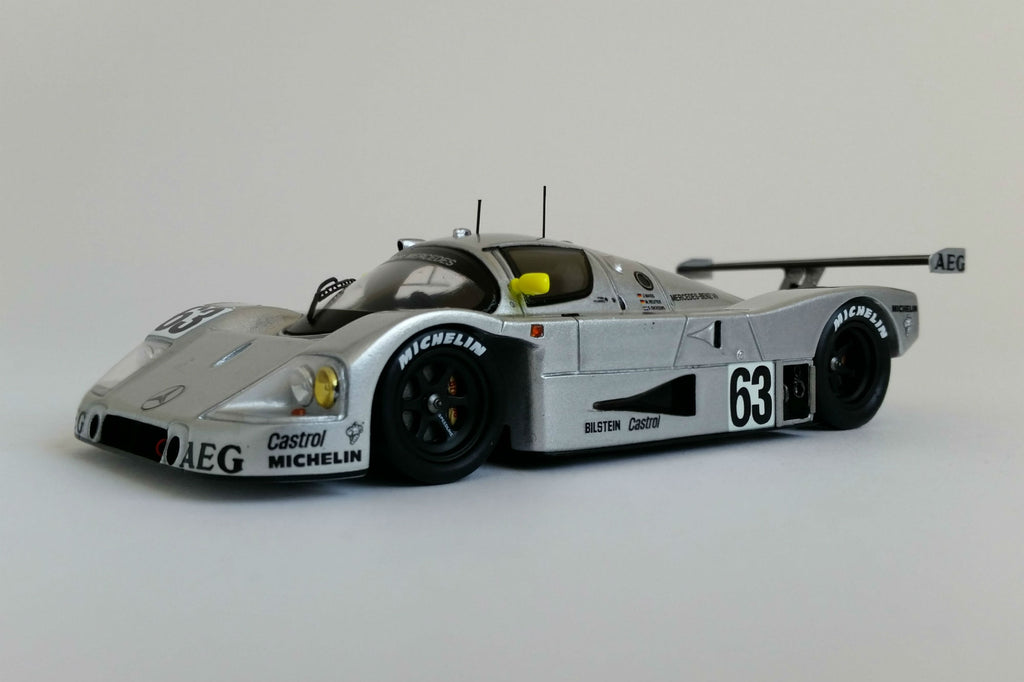

Though they would win both the Formula One Driver's Championship and World Sportscar Championship in 1955, the unthinkable horror of the 1955 24 Hours of Le Mans would signal the effective end of Mercedes Benz's official participation in motorsport for three decades. True, there would be privateer efforts in touring cars like the famous AMG "Red Pig" of the early '70s, and an abortive effort to go rallying in the latter part of that decade with the 450SLC 5.0, but at racing's highest levels, there was a giant hole in the shape of a three-pointed star for over thirty years.
By the middle of the 1980s, however, Mercedes' motorsport freeze had begun to thaw. Beginning in 1985, Mercedes partnered with prototype constructor Sauber to provide engines for its Group C program, then the hottest, most glamorous racing series on the planet. A twin-turbocharged version of the 5-liter M117 production V-8 was mounted in the middle of Sauber's new C8 racer, creating a Le Mans racer with 230-mile-per-hour potential. The Kouros-liveried C8 had limited development time, but was still able to qualify 17th for the 1985 running of the 24 Hours of Le Mans, but a practice crash left the car unable to compete. Though no further races would be run by the upstart partnership that year, 1986 would see Sauber-Mercedes contest a full year of the World Sportscar Championship, and though success was mostly elusive in the face of the mighty Porsche 956 and 962, the team at last saw victory at the Nurburgring 1000km...significantly, in front of a crowd of Mercedes-Benz executives.

Perhaps incentivized by success at Nurburgring, development of a new car commenced with even stronger factory participation by Mercedes-Benz. In 1987, the Sauber-Mercedes C9 was introduced, and though essentially an evolution of the C8, the new car would feature a much-improved suspension, a stiffer monocoque, and better aerodynamics than its predecessor. Still running Kouros livery, hopes were high for more consistent results in 1987, but it was not to be, as the season would be utterly dominated by Jaguar's new XJR-8 Group C coupe. There were, however, hints of the C9's potential, as the car set a new lap record at Le Mans before retiring with a broken gearbox.
The true turning point for the Sauber-Mercedes C9, and indeed for Mercedes-Benz's future participation in motorsport, occurred in the 1988 World Sportscar Championship. With new senior management installed at Mercedes, it was decided that the company would formally, officially support the Sauber sportscar program. With Kouros pushed aside for AEG-Olympia sponsorship, and with a full year of development under its belt, the C9 would prove a worthy adversary for the next evolution of the Group C Jaguar, the XJR-9. In a titanic season-long battle, Sauber-Mercedes would claim five wins from eleven starts...good enough for second place in the championship. Jaguar, however, would continue to have the upper hand, winning the other six races (most significantly, the 24 Hours of Le Mans). Undaunted, Team Sauber Mercedes would march into 1989 with an eye on dominance in the World Sportscar Championship, and with it sports car racing's greatest prize: victory at Le Mans.

With the addition of the new M119 twin-turbo V-8, featuring aluminum heads and four valves per cylinder, the C9 would at last achieve glory in the 1989 season, winning seven races out of eight, including, at last, the 24 Hours of Le Mans...the race that had driven Mercedes-Benz from the motorsport stage 34 years earlier. Significantly, the C9s would run the entire 1989 season (including that magical win at Le Mans) wearing pure silver paint jobs and very little sponsorship badging...it was truly the return of the Silver Arrows.
The rest of the story should be familiar to racing fans by now: though Group C racing would come to an end just a few years later, Mercedes-Benz would go on to become one of the most dominant forces in motorsport, with a record to rival all-time titans such as Porsche and Ferrari. As an engine supplier, Mercedes would transition to Formula 1, first with Sauber and later with McLaren and Brawn (winning constructor's championship for the latter two in 1998 and 2009, respectively). Becoming a standalone constructor in 2010, Mercedes GP would sweep the drivers' and constructors' championships from 2014 to 2017. Additionally, Mercedes cars would continue to find success in GT and touring car racing for the past 30 years, with an overall record of success that is the envy of every car company in the world. This three-decade renaissance for the Mercedes badge finds its source in the beautiful, blindingly fast C9 prototype that returned the three-pointed star to glory at Le Mans.
